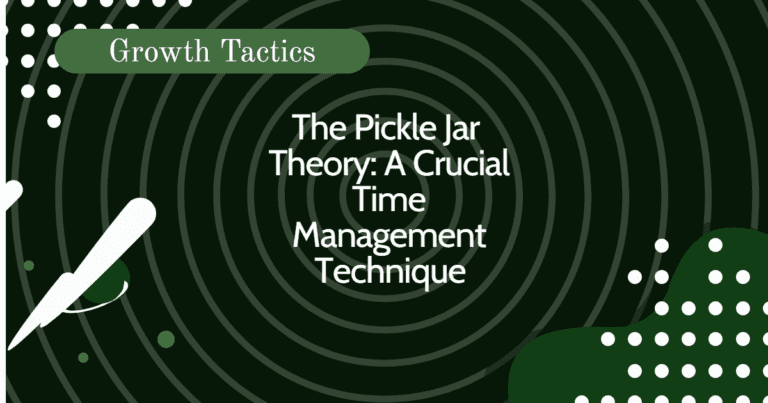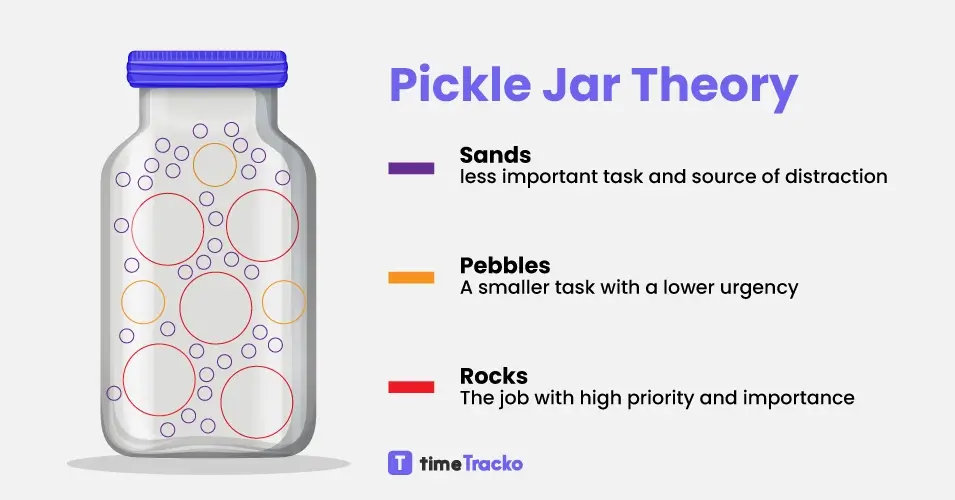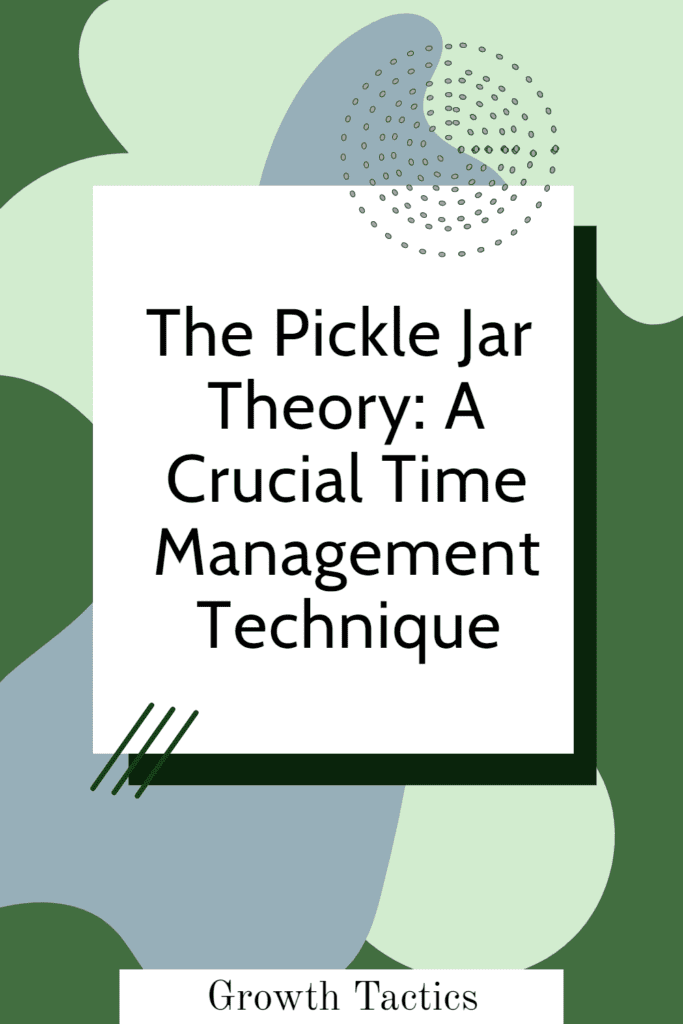Proper time management is a critical skill that allows individuals to accomplish their goals effectively. With numerous tasks and commitments on our plate, it can be overwhelming to figure out where to start and how to prioritize our time. This is where the Pickle Jar Theory comes in.
Jump To Section
Explanation of the Pickle Jar or Bucket of Rocks Theory
The Pickle Jar Theory is a simple yet powerful technique that compares time management to a jar filled with pickles of different sizes. By categorizing and prioritizing tasks like pickles, we can effectively manage our time and focus on what truly matters. Let’s explore the key steps of this technique:
The Concept
The concept behind the Pickle Jar Theory is to divide tasks into three categories: high-priority, medium-priority, and low-priority. Similar to how large pickles take up more space in a jar, high-priority or urgent tasks should receive the most attention and time. Medium-priority or less important tasks are like medium-sized pickles or pebbles, and low-priority tasks are represented by small pickles or sand.

Step-by-Step Guide to Implementing the Pickle Jar Theory
The first crucial step is to identify your main goals or priorities. Ask yourself: What are the most important things you need to accomplish? By determining your top priorities, you’ll have a clear focus and direction.
Here’s a helpful tip: Prioritize tasks that align with your long-term vision or have a significant impact on your personal or professional growth. This will ensure that you’re dedicating your time to what truly matters.
Step 2: Categorizing your tasks into different sizes
Now that you have a to-do list of tasks, it’s time to categorize them into different sizes. Just like pickles come in various sizes, tasks can be small, medium, or large.
For example, small tasks may include replying to emails, making phone calls, or scheduling appointments. Medium tasks could be completing a project milestone or preparing a presentation. Finally, large tasks might involve launching a new product, writing a research paper, or organizing a major event.
Step 3: Filling your pickle jar with tasks
Once you have categorized your tasks, it’s time to fill the jar! Start by placing the large tasks first, as they require the most time and effort. Remember, the key here is prioritization.
Here’s a pro tip: Use the smaller tasks to fill in the gaps between the larger ones. This ensures continuous progress and prevents wasted time. Don’t underestimate the power of small tasks; they can make a huge difference in the overall efficiency of your time management.
Step 4: Managing your time effectively
Now that your pickle jar is filled with tasks, it’s crucial to manage your time effectively. Here are some tips to make the most out of each task size:
- For small tasks: Set specific time slots, like 15-30 minutes, to tackle these tasks efficiently. Batch similar tasks together to minimize context switching and enhance productivity.
For medium tasks: Allocate dedicated blocks of time, preferably 1-2 hours, where you can fully immerse yourself in the task at hand. This focused approach will help you achieve significant progress.
For large tasks: Divide these tasks into manageable chunks and set realistic deadlines for each sub-task. By breaking them down, you’ll be able to tackle them systematically without feeling overwhelmed.
It’s worth mentioning the importance of taking breaks and allowing some time for rest. Remember, overworking can lead to burnout, so make sure to include moments of relaxation in your time management blueprint.

Benefits of Using the Pickle Jar Theory
So, why should you apply the Pickle Jar Theory in your life? Here are some key benefits:
1. Efficient Time Management: By focusing on high-priority tasks, you can allocate your time and energy more effectively, ensuring crucial tasks are addressed first.
2. Reduced Stress and Overwhelm: Breaking down tasks into manageable sizes helps to alleviate stress and overwhelm. With the Pickle Jar Theory, you can approach tasks step-by-step, focusing on one pickle at a time, and avoiding feeling overwhelmed by the jar.
3. Increased Productivity: By organizing tasks based on their priority levels, you can maximize your productivity. Completion of high-priority tasks gives you a sense of accomplishment and motivates you to tackle other pickles on your list.
Practical Application of the Pickle Jar Theory
Implementing the Pickle Jar Theory requires a thoughtful approach when assessing tasks and setting priorities:
1. Analyzing Urgency, Importance, and Impact
Take the time to assess the urgency, importance, and impact of each task. Consider deadlines, potential consequences of delay, and the value each task brings towards achieving your goals. Also give a time estimate to each task. This analysis will help you determine which tasks should be classified as large, medium, or small pickles.
2. Aligning Tasks with Goals
Consider how each task aligns with your personal and professional goals. Tasks that contribute directly to your objectives should be given higher priority. This alignment ensures that your focus is directed towards tasks that truly matter in the long run.
Utilizing Time-Blocking Techniques
Time-blocking is a useful technique when applying the Pickle Jar Theory:
1. Allocating Dedicated Time Slots
Allocate specific time slots for different pickle sizes or tasks. For example, dedicate your most productive hours to tackling high-priority tasks. By assigning time blocks for each task category, you create a structured approach to manage your time effectively.
2. Minimizing Distractions
During the designated time blocks, minimize distractions to ensure maximum focus and productivity. Turn off notifications on your phone or computer, find a quiet space to work, and communicate with others that you need uninterrupted time to complete important tasks. By staying focused, you can accomplish more within the allocated timeframes.
Adapting and Adjusting as Necessary
The Pickle Jar Theory is versatile and allows for adaptation:
1. Regular Review of Priorities
Regularly review your priorities and adjust if needed. As circumstances change, certain tasks may become more or less urgent or important. By reassessing and reprioritizing, you can ensure that your time and energy are invested in the right tasks.
2. Modifying the Sizes of Pickles
Be open to modifying the sizes of pickles based on changes in priorities or available resources. Sometimes, what was once a high-priority task may become less urgent, allowing you to adjust your focus accordingly.
“The key to mastering time management lies in embracing the Pickle Jar Theory. Learn how this crucial technique can transform your productivity and free you from overwhelm! #timemanagement #productivityhacks”
Real-Life Examples and Success Stories
Overcoming Procrastination: How Jessica Took Control of her Life
Meet Jessica. She was the queen of procrastination, always finding herself racing against the clock to complete her daily tasks. It seemed like she was constantly overwhelmed and stressed. That was until she discovered the Pickle Jar Theory.
Following the theory’s principles, Jessica started categorizing her tasks based on their urgency and importance. She realized that by tackling the most critical tasks first, she could make significant progress and relieve the pressure she felt. As a result, Jessica began completing her projects well ahead of time and witnessed a positive impact on her overall well-being.
Career Advancement: John’s Journey to Professional Success
John had been feeling stuck in his career for years. He saw his peers climbing the corporate ladder while he remained stagnant. It wasn’t until he stumbled upon the Pickle Jar Theory that things started to change for him.
Applying the principles of the theory, John began prioritizing his work tasks by considering their long-term value and aligning them with his career goals. This shift in focus brought about a remarkable boost in productivity. John’s colleagues and superiors noticed his improved performance, leading to glowing performance reviews, recognitions, and, eventually, a well-deserved promotion.
Personal Growth: Samantha’s Path to Self-Improvement
Samantha had always felt like there was never enough time for her personal development. She juggled work, family commitments, and daily responsibilities, leaving her feeling overwhelmed and unsatisfied. That’s when she stumbled upon the Pickle Jar Theory.
By following the theory’s time management principles, Samantha learned to allocate dedicated time for activities such as exercising, reading, and pursuing her hobbies. She realized that taking care of her personal growth was just as important as any other task. As a result, Samantha experienced a significant improvement in her overall well-being and happiness, as well as exponential personal growth and the acquisition of new skills.
Entrepreneurial Success: Alex’s Journey to Building a Thriving Startup
Alex had long dreamed of starting his own business, but he found himself overwhelmed with the countless tasks involved. He lacked a clear plan and struggled to stay focused. That’s when he learned about the Pickle Jar Theory.
Inspired by the theory’s principles, Alex applied the concept to his entrepreneurial journey. He began categorizing his tasks and identifying key activities that would drive the growth of his startup. By prioritizing these tasks and focusing on what truly mattered, he successfully launched his business. Today, Alex’s startup is thriving, thanks to his ability to effectively manage all aspects of the business with the help of the Pickle Jar Theory.
Achieving Work-Life Balance: Sarah’s Transformation to Harmonize Her Life
Sarah was constantly torn between her demanding career and her personal life. She found it challenging to strike a balance and often felt burnt out. That’s when she discovered the Pickle Jar Theory.
With the help of the theory, Sarah learned to categorize her priorities and allocate adequate time for work, family, self-care, and leisure. This newfound balance had a profound impact on her well-being. Sarah experienced a significant reduction in stress levels, improved relationships, and a newfound sense of fulfillment in both her personal and professional spheres.
Conclusion
The Pickle Jar Theory is a powerful time management technique that allows for efficient prioritization and productive goal achievement. By categorizing tasks and focusing on high-priority pickles, you can reduce stress, improve productivity, and achieve the desired outcomes in your personal and professional life. Apply the Pickle Jar Theory and discover the positive impact it can have on your time management skills and overall success.



